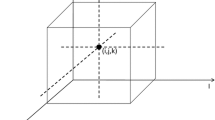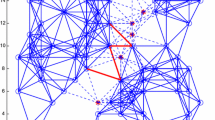Abstract
Given polyhedron P and and a point \(x^*\), the separation problem for polyhedra asks to certify that \(x^*\in P\) and if not, to determine an inequality that is satisfied by P and violated by \(x^*\). This problem is repeatedly solved in cutting plane methods for Integer Programming and the quality of the violated inequality is an essential feature in the performance of such methods. In this paper we address the problem of finding efficiently an inequality that is violated by \(x^*\) and either defines an improper face or a facet of P. We show that, by solving a single linear program, one almost surely obtains such an improper face or facet.




Similar content being viewed by others
References
Andersen, K., Louveaux, Q., Weismantel, R., Wolsey, L.A.: Cutting Planes from two rows of a simplex tableau. In: Proceedings of IPCO XII, Ithaca, New York, Lecture Notes in Computer Science, vol. 4513, pp. 1–15 (2007)
Balas, E.: Disjunctive programming: properties of the convex hull of feasible points. In: GSIA Management Science Research Report MSRR 348, Carnegie Mellon University (1974), published as invited paper. Discrete Applied Mathematics, vol. 89, pp. 1–44 (1998)
Balas, E.: Disjunctive programming. Ann. Discret. Math. 5, 3–51 (1979)
Balas, E., Ceria, S., Cornuéjols, G.: A lift-and-project cutting plane algorithm for mixed 0–1 programs. Math. Program. 58, 295–324 (1993)
Balas, E., Perregaard, M.: Lift-and-project for mixed 0–1 programming: recent progress. Discret. Appl. Math. 123, 129–154 (2002)
Balas, E., Perregaard, M.: A precise correspondence between lift-and-project cuts, simple disjunctive cuts and mixed integer Gomory cuts for 0–1 programming. Math. Program. B 94, 221–245 (2003)
Benders, J.F.: Partitioning procedures for solving mixed variables programming problems. Numerische Mathematik 4, 238–252 (1962)
Ben-Tal, A., Nemirovski, A.: Lectures on Modern Convex Optimization. MPS-SIAM series on optimization. SIAM, Philadelphia (2001)
Bonami, P.: Etude et mise en oeuvre d’approches polyédriques pour la résolution de programmes en nombres entiers ou mixtes généraux, PhD thesis, Université de Paris 6 (2003)
Cadoux, F.: Computing deep facet-defining disjunctive cuts for mixed-integer programming. Math. Program. A 122, 197–223 (2010)
Conforti, M., Cornuéjols, G., Zambelli, G.: Integer Programming. Springer, New York (2014)
Cornuéjols, G., Lemaréchal, C.: A convex-analsis perspective of disjunctive cuts. Math. Program. A 106, 567–586 (2006)
Crowder, H., Johnson, E.L., Padberg, M.W.: Solving large-scale zero-one linear programming problems. Oper. Res. 31, 803–834 (1983)
Fischetti, M., Lodi, A., Tramontani, A.: On the separation of disjunctive cuts. Math. Program. 128, 205–230 (2011)
Fischetti, M., Salvagnin, D.: An in-out approach to disjunctive optimization. CPAIOR Lect. Notes Comput. Sci. 6140, 136–140 (2010)
Fischetti, M., Salvagnin, D., Zanette, A.: A note on the selection of Benders’ cuts. Math. Program. B 124, 175–182 (2010)
Freund, R.M., Roundy, R., Todd, M.J.: Identifying the set of always-active constraints in a system of linear inequalities by a single linear program, Sloan W.P. No. 1674-85 (1985)
Hiriart-Urruty, J.B., Lemaréchal, C.: Fundamentals of Convex Analysis. Springer, New York (2001). Grundlehren Text Editions
Magnanti, T.L., Wong, R.T.: Accelerating benders decomposition: algorithmic enhancement and model selection criteria. Oper. Res. 29, 464–484 (1981)
Mehdiloozad, M., Tone, K., Askarpour, R., Ahmadi, M.B.: Finding a maximal element of a non-negative convex set through its characteristic cone: an application to finding a strictly complementary solution. Comput. Appl. Math. (2016) (to appear)
Nemhauser, G.L., Wolsey, L.A.: Integer and Combinatorial Optimization. Wiley, New York (1988)
Papadakos, N.: Practical enhancements to the Magnanti–Wong method. Oper. Res. Lett. 36, 444–449 (2008)
Padberg, M.W., Grötschel, M.: Polyhedral computations, Ch. 9. In: Lawler, E.L., Lenstra, J.K., Rinnooy Kan, A.H.G., Shmoys, D.B. (eds.) The Traveling Salesman Problem. Wiley, New York (1985)
Pochet, Y., Wolsey, L.A.: Lot-sizing models with backlogging: strong formulations and cutting planes. Math. Program. 40, 317–335 (1988)
Rardin, R.L., Choe, U.: Tighter relaxations of fixed charge network flow problems, Report J-79-18. Industrial and Systems Engineering, Georgia Institute of Technology (1979)
Rardin, R., Wolsey, L.A.: Valid inequalities and projecting the multicommodity extended formulation for uncapacitated fixed charge network flow problems. Eur. J. Oper. Res. 71, 95–109 (1993)
Walter, M.: Investigating Polyhedra by Oracles and Analyzing Simple Extensions of Polytopes a Doctoral Dissertation, Otto-von-Guericke-Universität Magdeburg (2016)
Acknowledgements
The authors gratefully acknowledge that this work started at the University of Bonn when they were participants in the Hausdorff Trimester Program on “Combinatorial Optimization”. They also thank three referees for their constructive comments.
Author information
Authors and Affiliations
Corresponding author
Additional information
M. Conforti: Supported by Grants SID 2016 and PRIN 2016.
Rights and permissions
About this article
Cite this article
Conforti, M., Wolsey, L.A. “Facet” separation with one linear program. Math. Program. 178, 361–380 (2019). https://doi.org/10.1007/s10107-018-1299-8
Received:
Accepted:
Published:
Issue Date:
DOI: https://doi.org/10.1007/s10107-018-1299-8
Keywords
- Integer programming
- Separation problem
- Polyhedra
- Extended formulations
- Facets
- Cutting plane algorithm
- Split inequalities




